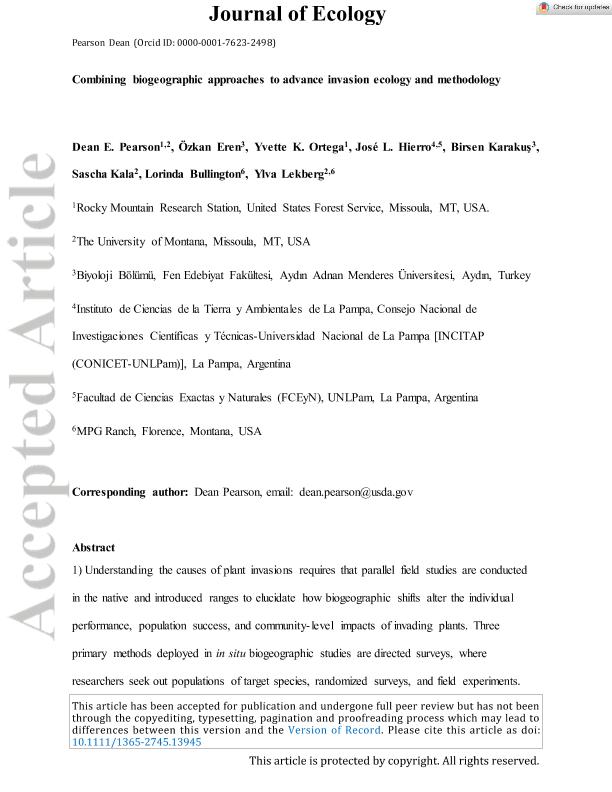Artículo
Combining biogeographical approaches to advance invasion ecology and methodology
Pearson, Dean; Eren, Ozkan; Ortega, Yvette K.; Hierro, Jose Luis ; Karakuş, Birsen; Kala, Sascha; Bullington, Lorinda; Lekberg, Ylva
; Karakuş, Birsen; Kala, Sascha; Bullington, Lorinda; Lekberg, Ylva
 ; Karakuş, Birsen; Kala, Sascha; Bullington, Lorinda; Lekberg, Ylva
; Karakuş, Birsen; Kala, Sascha; Bullington, Lorinda; Lekberg, Ylva
Fecha de publicación:
06/2022
Editorial:
Wiley Blackwell Publishing, Inc
Revista:
Journal of Ecology
ISSN:
0022-0477
Idioma:
Inglés
Tipo de recurso:
Artículo publicado
Clasificación temática:
Resumen
Understanding the causes of plant invasions requires that parallel field studies are conducted in the native and introduced ranges to elucidate how biogeographical shifts alter the individual performance, population success and community-level impacts of invading plants. Three primary methods deployed in in situ biogeographical studies are directed surveys, where researchers seek out populations of target species, randomized surveys and field experiments. Despite the importance of these approaches for advancing biogeographical research, their relative merits have not been evaluated. We concurrently deployed directed surveys, randomized surveys and in situ field experiments for studying six grassland plant species in the native and introduced ranges. Metrics included plant size, fecundity, recruitment, abundance and invader impact, as well as soil properties and root associations with putative fungal mutualists and pathogens. Consistent with key invasion hypotheses, Bromus tectorum experienced increased size and fecundity in the introduced range linked to population increases and significant invader impacts, along with altered fungal associations. However, performance differences did not predict population increases and invader impacts across species. A notable finding was that disturbance facilitated greater recruitment in the introduced range for most species, thereby playing a crucial, though underappreciated, role in driving invader success. Directed surveys consistently generated information on plant performance and fungal associations. However, soil sampling suggested that directed surveys may have been biased towards disturbed conditions for half the species. Randomized surveys generated robust data for population comparisons and impact, but generally failed to produce performance metrics for species that were uncommon or flowered outside the peak sampling window. Field experiments controlled for bias and confounding factors and provided rare information on recruitment and disturbance effects, but poor recruitment in the native range and ethical constraints on growing invaders in the introduced range hindered comparisons of performance and plant–fungal interactions. Synthesis. Each method had strengths and weaknesses. However, when combined they provided complementary information to paint the most complete biogeographical picture to date for several introduced plants. We propose a hybrid approach to optimize biogeographical studies.
Archivos asociados
Licencia
Identificadores
Colecciones
Articulos(INCITAP)
Articulos de INST.D/CS D/L/TIERRA Y AMBIENTALES D/L/PAMPA
Articulos de INST.D/CS D/L/TIERRA Y AMBIENTALES D/L/PAMPA
Citación
Pearson, Dean; Eren, Ozkan; Ortega, Yvette K.; Hierro, Jose Luis; Karakuş, Birsen; et al.; Combining biogeographical approaches to advance invasion ecology and methodology; Wiley Blackwell Publishing, Inc; Journal of Ecology; 110; 9; 6-2022; 2033-2045
Compartir
Altmétricas



